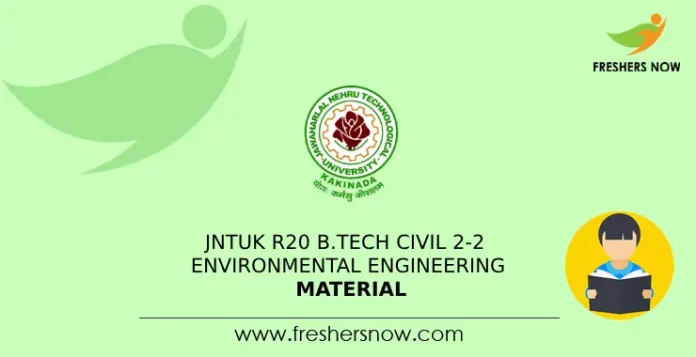
JNTUK R20 B.Tech Civil 2-2 Environmental Engineering Material/ Notes PDF Download: Our meticulously curated material aligns perfectly with the objectives set forth by the university. Covering a range of topics, including planning and designing water supply systems for communities, understanding water quality requirements for domestic use, and the significance of protecting water sources, our material provides students with a holistic understanding of environmental engineering. Additionally, students will gain insights into the process of converting raw water into clean potable water and learn about the selection of valves and fixtures in water distribution systems. Download the JNTUK R20 B.Tech Civil 2-2 Environmental Engineering Material PDF from the given below links.
JNTUK R20 B.Tech Civil 2-2 Environmental Engineering Material – Units
| No. Of Units | Name of the Unit |
| Unit – 1 | Introduction, Water Demand and Quantity Estimation, Sources of Water |
| Unit – 2 | Treatment of Water, Disinfection |
| Unit – 3 | Collection and Conveyance of Water, Distribution of Water |
| Unit – 4 | Sewerage, House Plumbing |
| Unit – 5 | Sewage characteristics, Treatment of Sewage, Ultimate Disposal of Sewage |
Unit 1 Syllabus PDF Download | JNTUK R20 B.Tech Civil 2-2 Environmental Engineering Material
Introduction: Importance and Necessity of Protected Water Supply systems, Water borne diseases, Flow chart of public water supply system, Role of Environmental Engineer, Agency activities.
Water Demand and Quantity Estimation: Estimation of water demand for a town or city, Per capita Demand and factors influencing it – Types of water demands and its variations- factors affecting water demand, Design Period, Factors affecting the Design period, Population Forecasting.
Sources of Water: Lakes, Rivers, Comparison of sources about quality, quantity, and other considerations- Ground water sources: springs, Wells, and Infiltration galleries, Characteristics of water– Physical, Chemical, and Biological characteristics and WHO guidelines for drinking water – IS 10500 2012 – Water quality standards for Agriculture, Industries and Construction.
| JNTUK R20 B.Tech 2-2 Environmental Engineering Material – PDF Download | |
| To Download JNTUK R20 B.Tech Civil Environmental Engineering Material Unit – 1 PDF | Download PDF |
Unit 2 Syllabus PDF Download | JNTUK R20 B.Tech Civil 2-2 Environmental Engineering Material
Treatment of Water: Treatment methods: Theory and Design of Sedimentation, Coagulation, Filtration.
Disinfection: Theory of disinfection-Chlorination and other Disinfection methods. Removal of color and odors- Removal of Iron and Manganese – Adsorption- Fluoridation and deflouridation–Reverse Osmosis- Solar stills- Freezing.
| JNTUK R20 B.Tech 2-2 Environmental Engineering Material – PDF Download | |
| To Download JNTUK R20 B.Tech Civil Environmental Engineering Material Unit – 2 PDF | Download PDF |
Unit 3 Syllabus PDF Download | JNTUK R20 B.Tech Civil 2-2 Environmental Engineering Material
Collection and Conveyance of Water: Factors governing the selection of the intake structure, Conveyance of Water: Gravity and Pressure conduits, Types of Pipes, Pipe Materials, Pipe joints, Design aspects of pipelines, Design of economical diameter of pumping main, HP of the pump and monthly expenditure for an apartment and a village. Laying and testing of pipelines- Capacity of storage reservoirs, Mass curve analysis.
Distribution of Water: Methods of Distribution system, Layouts of Distribution networks, Water main appurtenances – Sluice valves, Pressure relief valves, air valves, check valves, hydrants, and water meters–Ideal water supply system. Case studies.
| JNTUK R20 B.Tech 2-2 Environmental Engineering Material – PDF Download | |
| To Download JNTUK R20 B.Tech Civil Environmental Engineering Material Unit – 3 PDF | Download PDF |
Unit 4 Syllabus PDF Download | JNTUK R20 B.Tech Civil 2-2 Environmental Engineering Material
Sewerage: Estimation of sewage flow and storm water drainage – fluctuations – types of sewers – design of sewers. Sewer appurtenances – cleaning and ventilation of sewers. Sewage pumps.
House Plumbing: Systems of plumbing-sanitary fittings and other accessories– one pipe and two pipe systems – Design of drainage in Gated communities, Apartments, and Hotels. Septic Tank – working Principles and Design.
| JNTUK R20 B.Tech 2-2 Environmental Engineering Material – PDF Download | |
| To Download JNTUK R20 B.Tech Civil Environmental Engineering Material Unit – 4 PDF | Download PDF |
Unit 5 Syllabus PDF Download | JNTUK R20 B.Tech Civil 2-2 Environmental Engineering Material
Sewage characteristics: Characteristics of sewage – BOD equations. ThOD, COD, and BOD.
Treatment of Sewage: Primary treatment. Secondary treatment: Activated Sludge Process, principles, designs, and operational problems. Oxidation ponds, Trickling Filters – classification – design, operation, and maintenance problems. RBCs. Fluidized bed reactors –Anaerobic digestion of sludge, Sludge Drying Beds.
Ultimate Disposal of Sewage: Methods of disposal – disposal into water bodies-Oxygen Sag Curve Disposal into sea, disposal on land, Crown corrosion, Sewage sickness. Effluent standards.
| JNTUK R20 B.Tech 2-2 Environmental Engineering Material – PDF Download | |
| To Download JNTUK R20 B.Tech Civil Environmental Engineering Material Unit – 5 PDF | Download PDF |
For more details about JNTUK R20 B.Tech Civil 2-2 Environmental Engineering Material PDF Download and other materials follow our official website Freshersnow.com.
JNTUK R20 B.Tech Civil 2-2 Environmental Engineering Notes – Outcomes
- Plan and design water and distribution networks along with sewerage systems.
- Identify suitable water sources and choose appropriate intake structures.
- Characterize water to ensure quality and suitability for various uses.
- Select the necessary appurtenances in water supply systems to ensure efficient operation.
- Choose suitable treatment processes for raw water treatment to enhance water quality and safety.



